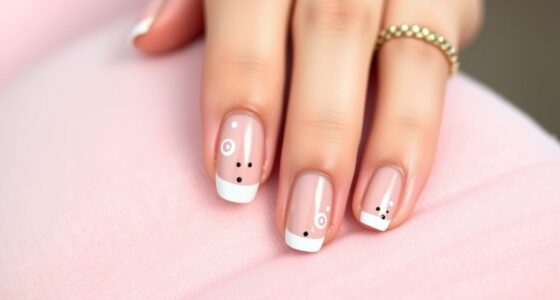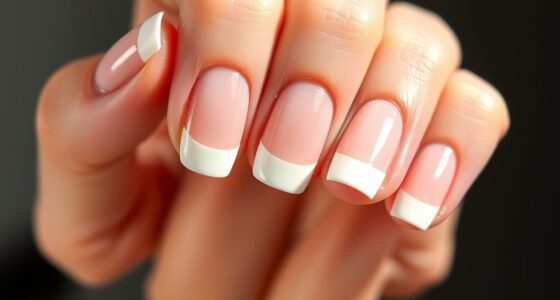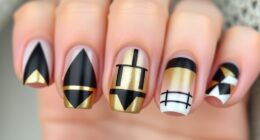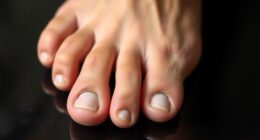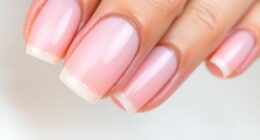Pushing cuticles is gentler and helps maintain nail health by preventing dead skin buildup, but it requires careful technique to avoid damage or infection. Cutting cuticles gives a cleaner, sharper look and can remove excess tissue more effectively, but it carries a higher risk of infection and nail damage if not done properly. Thinking about which method suits your nail health and appearance goals can help, and understanding the details can guide your choice.
Key Takeaways
- Pushing cuticles is gentler and helps prevent damage, while cutting offers a cleaner, more immediate aesthetic.
- Cutting cuticles can pose higher infection risks if tools are not properly sanitized.
- Pushing maintains nail health by avoiding trauma, whereas cutting may damage the nail bed if not performed carefully.
- Cutting provides a sharper, more polished look but requires skill to avoid injury.
- Proper technique and sanitation are essential for both methods to ensure safe and effective cuticle care.
Benefits and Drawbacks of Pushing Cuticles

Pushing cuticles can make your nails look cleaner and more polished, giving them a neat appearance. When done correctly, it’s a gentle way to tidy up your nail area without risking damage to the nail bed. This method helps maintain nail health by preventing the buildup of dead skin that can trap dirt and bacteria. Since you’re not cutting, the infection risk decreases, especially if you use sanitized tools and proper technique. Additionally, understanding cuticle health and proper technique can help prevent common issues. Proper tool sanitation is essential to avoid the transfer of bacteria and fungi that can cause infections. Staying informed about nail health maintenance can further support your overall nail care routine. Incorporating self-care practices such as regular moisturizing can also enhance the health of your cuticles and nails. Overall, when done correctly, pushing cuticles is a safe way to enhance the appearance of your nails while minimizing risks.
Advantages and Disadvantages of Cutting Cuticles

Cutting cuticles can create a very clean and polished look, which many people find appealing. However, it also comes with risks. While it may enhance aesthetic appeal, it can compromise nail health if done improperly, leading to infections or damage. Cutting too deep might cause pain or bleeding, making your nails vulnerable to bacteria. On the upside, it offers a neat appearance and can prevent hangnails. But, the disadvantages include potential nail bed trauma and increased sensitivity. Consider the emotional impact:
| Pros | Cons |
|---|---|
| Sharp, clean look | Risk of infection |
| Prevents hangnails | Damage to nail bed |
| Immediate aesthetic boost | Pain or bleeding possible |
| Removes excess cuticle | Compromises nail health |
| Easy to achieve | Requires skill and caution |
Additionally, improper cutting can also lead to infection risks, emphasizing the importance of proper technique and tools. Proper sanitation and technique are vital to minimize bacterial contamination and ensure healthy nail growth. Using appropriate tools and following correct procedures can significantly reduce the likelihood of complications.
Frequently Asked Questions
Can Pushing Cuticles Prevent Hangnails Better Than Cutting?
Pushing your cuticles can help prevent hangnails better than cutting because it promotes proper cuticle maintenance and preserves nail health. When you push gently, you avoid damaging the sensitive skin, reducing the risk of hangnails forming. Cutting, on the other hand, can cause tears and infections. By maintaining your cuticles carefully, you keep your nails healthier and less prone to painful hangnails, making pushing a safer option overall.
How Often Should I Push or Cut My Cuticles?
Think of your cuticles as the gatekeepers of your nails’ kingdom. You should push them gently once a week to avoid nail damage and reduce infection risk. Avoid cutting too often or aggressively, as it can lead to damage or infections. Regular, careful maintenance keeps your cuticles healthy, protecting your nails while preventing hangnails. Listen to your nails’ needs and don’t overdo it, ensuring their natural barrier stays intact.
Are There Any Long-Term Health Risks With Cutting Cuticles?
You might wonder if cutting cuticles has long-term health risks. If you cut them improperly, it can damage your cuticle health and increase the risk of infections or nail safety issues. Over time, frequent cutting can lead to weakened nail growth and potential bacterial entry. To protect your nails, consider gentle cuticle care or pushing instead of cutting, and always use clean tools to minimize health risks.
Is Pushing Cuticles Safe for All Nail Types?
Think of your cuticles as the gatekeepers of your nails. Pushing them gently is usually safe for most nail types, but if done too aggressively, it can cause cuticle damage and open the door to nail infections. Be gentle, use proper tools, and avoid pushing if your cuticles are inflamed or brittle. This careful approach helps protect your nails and keeps them healthy and strong.
What Tools Are Best for Pushing Versus Cutting Cuticles?
When choosing tools for cuticle removal, use a wooden or rubber pusher to gently push back cuticles without damaging nail health. Metal tools are better suited for cutting stubborn cuticles or hangnails. Always be gentle to avoid irritation or injury. Proper tools help you maintain healthy nails and prevent infections. Remember, pushing cuticles is safer for most nail types, while cutting should be reserved for specific cases with precise tools.
Conclusion
Whether you choose to push or cut your cuticles, remember that each method has its benefits and drawbacks. Pushing your cuticles can be safer but might require more care, while cutting can give a cleaner look but risks damage. Ultimately, your choice depends on your nail health, your routine, and your preferences. Weigh the pros and cons carefully, prioritize safety, and choose what works best for you—because healthy, beautiful nails start with informed decisions.


